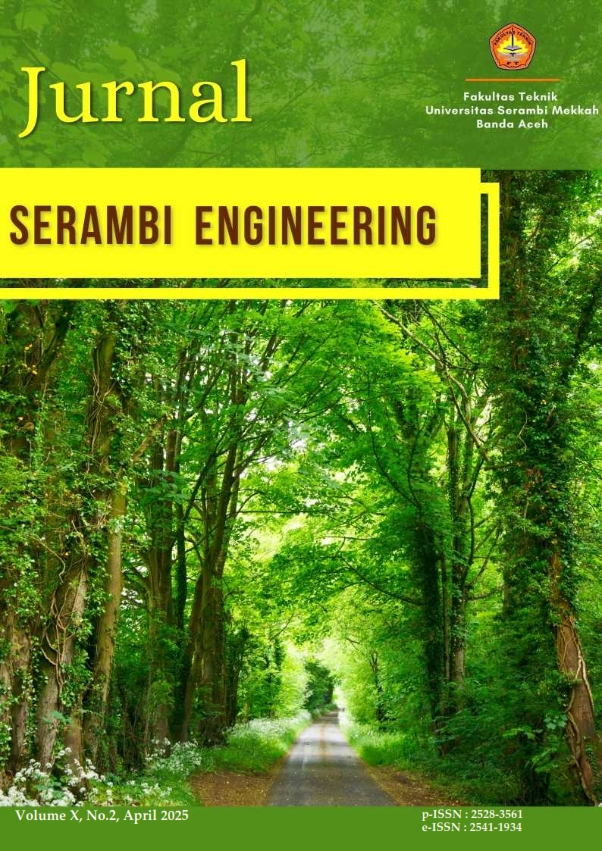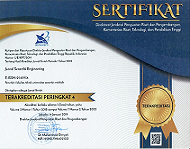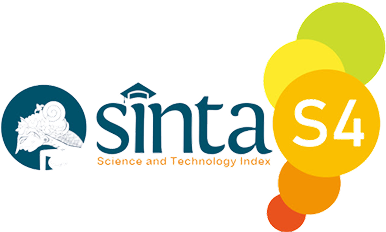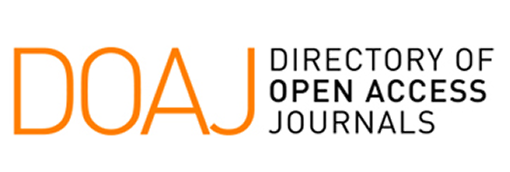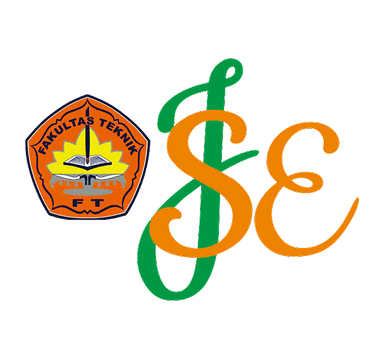Analysis of Wastewater Quality of Jetis Batik, Sidoarjo
Keywords:
Batik, Permenkes 02 Tahun 2023, PerGub Jatim 72 Tahun 2013, batik jetis, sidoarjoAbstract
Jetis Batik Industry in Sidoarjo is recognized as a prominent batik center in East Java. Batik is known as an industry that uses both natural and synthetic dyes. This can serve as a source of environmental pollution. This study is to evaluate the quality of wastewater generated by Jetis Batik in Sidoarjo. The determined quality is then evaluated according to Permenkes 02 of 2023 and PerGub Jatim Number 72 of 2013. In this research, batik wastewater samples from 20 batik cottage industries in the Jetis region of Sidoarjo were used. It is acknowledged that it does not meet the clean water quality standards set by the Minister of Health Regulation Number 02 of 2023 in terms of TDS parameters, turbidity, color, Fe, Mn, nitrate, nitrite, pH, and chromium. Subsequent research in accordance with East Java Governor Law No. 72 of 2013 showed that TDS, pH, Fe, Mn, Cr, COD and BOD exceeded the quality criteria established by law. In addition, according to the East Java Governor Regulation No. 72 of 2023, batik liquid waste is classified into categories I, II, III, IV, and seawater, which is considered unsuitable for discharge into the marine environment. Immediate disposal of batik liquid waste into water sources without prior treatment poses a significant risk of environmental contamination.
References
Amalia, R. A. H. T., Tasya, A. K., & Ramadhani, D. (2021). Kandungan Nitrit Dan Nitrat Pada Kualitas Air Permukaan. Prosiding Seminar Nasional Biologi, 1(1), 679–688. Https://Doi.Org/10.24036/Prosemnasbio/Vol1/87
Arohmah, N. E., & Rachmanto, T. A. (2023). Penurunan Konsentrasi Cod Limbah Cair Industri Batik Jetis Pada Proses Aklimatisasi Menggunakan Mikroorganisme Bacillus Sp. Envirous, 3(2). Https://Doi.Org/10.33005/Envirous.V3i2.20
Bener, S., Bulca, Ö., Palas, B., Tekin, G., Atalay, S., & Ersöz, G. (2019). Electrocoagulation Process for The Treatment of Real Textile Wastewater: Effect of Operative Conditions on The Organic Carbon Removal And Kinetic Study. Process Safety and Environmental Protection, 129, 47–54. Https://Doi.Org/Https://Doi.Org/10.1016/J.Psep.2019.06.010
Bharadwaj, A., & K, S. A. (2015). Decolorization Of the Textile Wastewater Containing Reactive Blue 19 Dye By Fenton And Photo-Fenton Oxidation. Journal Of Hazardous, Toxic, And Radioactive Waste, 19(4), 04014043. Https://Doi.Org/10.1061/(Asce)Hz.2153-5515.0000267
Birgani, P. M., Ranjbar, N., Abdullah, R. C., Wong, K. T., Lee, G., Ibrahim, S., Park, C., Yoon, Y., & Jang, M. (2016). An Efficient and Economical Treatment for Batik Textile Wastewater Containing High Levels of Silicate and Organic Pollutants Using A Sequential Process Of Acidification, Magnesium Oxide, And Palm Shell-Based Activated Carbon Application. Journal Of Environmental Management, 184, 229–239. Https://Doi.Org/Https://Doi.Org/10.1016/J.Jenvman.2016.09.066
Darvishi Cheshmeh Soltani, R., Jorfi, S., Alavi, S., Astereki, P., & Momeni, F. (2020). Electrocoagulation Of Textile Wastewater in The Presence of Electro-Synthesized Magnetite Nanoparticles: Simultaneous Peroxi- And Ultrasonic-Electrocoagulation. Separation Science and Technology, 55(5), 945–954. Https://Doi.Org/10.1080/01496395.2019.1574827
Daud, N. M., Abdullah, S. R. S., Hasan, H. A., Ismail, N. ’Izzati, & Dhokhikah, Y. (2022). Integrated Physical-Biological Treatment System for Batik Industry Wastewater: A Review on Process Selection. Science Of the Total Environment, 819, 152931. Https://Doi.Org/Https://Doi.Org/10.1016/J.Scitotenv.2022.152931
Demir, A., & Gören, N. (2019). Investigation Of Electrocoagulation and Electrooxidation Methods of Real Textile Wastewater Treatment. Anadolu University Journal of Science and Technology-A Applied Sciences and Engineering, 80–91. Https://Doi.Org/10.18038/Aubtda.445716
Elajel, M. A., Abdullah, A. Z., & Basir, N. I. (2022). Effects of Operational Parameters of Electrocoagulation Using Zinc Electrode on The Treatability of Textile Wastewater Electrocoagulation of Textile Wastewater. Journal Of Engineering Science, 18(1), 1–15.
Eskani, I. N., De Carlo, I., & Sulaeman, S. (2016). Efektivitas Pengolahan Air Limbah Batik Dengan Cara Kimia Dan Biologi. Dinamika Kerajinan Dan Batik, 22, 16–27.
Fardiaz, S. (1992). Mikrobiologi Pangan I. Gramedia Pustaka Utama.
Fauzi, A. M., & Defianisa, R. L. (2019). Analysis For Cleaner Production Implementation Strategy in Batik Industry in Bogor. Iop Conference Series: Earth and Environmental Science, 325(1), 012005. Https://Doi.Org/10.1088/1755-1315/325/1/012005
Handayani, E. H., Oginawati, K., & Santoso, M. (2020). Assessment Of Zn and Cu in Primary School Children’s Street Foods. Res. Environ. Sci. Eng, 1(1), 19–24.
Indarsih, W., Suprayogi, S., & Widyastuti, D. M. (2011). Kajian Kualitas Air Sungai Bedog Akibat Pembuangan Limbah Cair Sentra Industri Batik Desa Wijirejo.
Kalyani, D. C., Telke, A. A., Dhanve, R. S., & Jadhav, J. P. (2009). Ecofriendly Biodegradation and Detoxification of Reactive Red 2 Textile Dye by Newly Isolated Pseudomonas Sp. Suk1. Journal Of Hazardous Materials, 163(2), 735–742. Https://Doi.Org/Https://Doi.Org/10.1016/J.Jhazmat.2008.07.020
Kusworo, T. D., Irvan, Kumoro, A. C., Nabilah, Y., Rasendriya, A., Utomo, D. P., & Hasbullah, H. (2022). Advanced Method for Clean Water Recovery from Batik Wastewater Via Sequential Adsorption, Ozonation and Photocatalytic Membrane Pvdf-Tio2/Rgo Processes. Journal Of Environmental Chemical Engineering, 10(6), 108708. Https://Doi.Org/Https://Doi.Org/10.1016/J.Jece.2022.108708
Lokhande, V. H., Kudale, S., Nikalje, G., Desai, N., & Suprasanna, P. (2015). Hairy Root Induction and Phytoremediation of Textile Dye, Reactive Green 19a-He4bd, In A Halophyte, Sesuvium Portulacastrum (L.) L. Biotechnology Reports, 8, 56–63. Https://Doi.Org/Https://Doi.Org/10.1016/J.Btre.2015.08.002
Metcalf Dan Eddy. (1991). Wastewater Engineering: Treatment, Disposal and Reuse. Mc Graw Hill Book Co. Singapore.
Mukimin, A., Zen, N., Purwanto, A., Wicaksono, K. A., Vistanty, H., & Alfauzi, A. S. (2017). Application Of a Full-Scale Electrocatalytic Reactor as Real Batik Printing Wastewater Treatment by Indirect Oxidation Process. Journal Of Environmental Chemical Engineering, 5(5), 5222–5232. Https://Doi.Org/Https://Doi.Org/10.1016/J.Jece.2017.09.053
Rahayu, I. A. T., & Peng, L. H. (2020). Sustainable Batik Production: Review and Research Framework. International Conference on Research and Academic Community Services (Icracos 2019), 66–72.
Sulaeman; Mulyono, T.; R. E. ; R. Dan R. (2001). Teknologi Pengolahan Limbah Industri Kecil Batik. Departemen Perindustrian Dan Perdagangan Republik Indonesia. Badan Penelitian Dan Pengembangan Industri Dan Perdagangan, Yogyakarta.
Sulthonuddin, I., & Herdiansyah, H. (2021). Sustainability of Batik Wastewater Quality Management Strategies: Analytical Hierarchy Process. Applied Water Science, 11(2), 31. Https://Doi.Org/10.1007/S13201-021-01360-1
Taha, K., Elsheikh, M. A., Saleh, H., & Guirguis, H. (2020). Adding Alum Through Electrocoagulation with Rotating Anodes for Treating Dyes from Wastewaters. Innovative Infrastructure Solutions, 6(1), 17. Https://Doi.Org/10.1007/S41062-020-00376-X
Triwiswara, M. (2019). Efficiency Assessment of Batik Industry Wastewater Treatment Plant in Center for Handicraft and Batik Indonesia. Https://Doi.Org/10.2991/Icosite-19.2019.23
Velusamy, S., Roy, A., Sundaram, S., & Kumar Mallick, T. (2021). A Review on Heavy Metal Ions and Containing Dyes Removal Through Graphene Oxide-Based Adsorption Strategies for Textile Wastewater Treatment. The Chemical Record, 21(7), 1570–1610. Https://Doi.Org/Https://Doi.Org/10.1002/Tcr.202000153
Vymazal, J. (2014). Constructed Wetlands for Treatment of Industrial Wastewaters: A Review. Ecological Engineering, 73, 724–751. Https://Doi.Org/Https://Doi.Org/10.1016/J.Ecoleng.2014.09.034
Widianto, E. D., Pakpahan, M. S. M., Faizal, A. A., & Septiana, R. (2018). Lora Qos Performance Analysis on Various Spreading Factor in Indonesia. 2018 International Symposium on Electronics and Smart Devices (Isesd), 1–5. Https://Doi.Org/10.1109/Isesd.2018.8605471
Wulandari, A. (2018). Analisis Beban Pencemaran Dan Kapasitas Asimilasi Perairan Pulau Pasaran Di Provinsi Lampung. Fakultas Pertanian, Universitas Lampung.
Yurida, M., Afriani, E., & Arita, S. (2013). Pengaruh Kandungan Cao Dari Jenis Adsorben Semen Terhadap Kemurnian Gliserol. Https://Api.Semanticscholar.Org/Corpusid:110628129
Downloads
Published
Issue
Section
License
Copyright (c) 2025 Ida Kusnawati Tjahjani, Aulia Nur Febrianti, Yanatra Budi Pramana, Manik Ayu Titisari (Author)

This work is licensed under a Creative Commons Attribution 4.0 International License.

